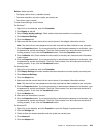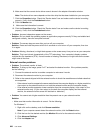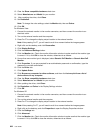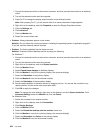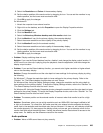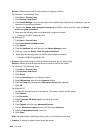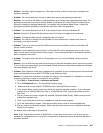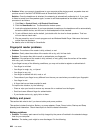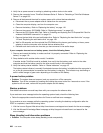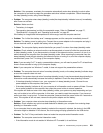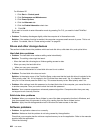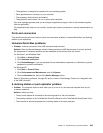
Solution: The slider might be grayed out. This means that its position is xed by the hardware and
cannot be changed.
• Problem: The volume sliders do not stay in place when some audio applications are used.
Solution: It is normal for the sliders to change position when certain sound applications are used. The
applications are aware of the Volume Mixer window (in Windows XP, Volume Control window) and are
allowed to change the settings themselves. An example is the Windows Media Player. Usually the
application has sliders available to control the sound from within the application.
• Problem: The volume sliders do not all t in the Volume Control window in Windows XP.
Solution: Press Ctrl+S keys while the volume control is in focus, and toggle to a smaller size.
• Problem: The balance slider cannot completely mute one channel.
Solution: The control is designed to compensate for minor differences in balance and does not
completely mute either channel.
• Problem: There is no volume control for MIDI sound on the Volume Mixer window (in Windows XP,
Volume Control window).
Solution: Use the hardware volume control. In Windows XP, use the hardware volume control or the
Wave volume control on the Volume Control window. This is because the Built-In Synthesizer Software
does not support the control.
• Problem: The sound cannot be turned off completely even if you set the Master volume control at
minimum.
Solution: You can still hear some sound even though you have set the Master volume control at minimum.
To turn off the sound completely, go to the Master volume control and select Mute speakers (in Windows
Vista and Windows XP, Mute).
• Problem: Sound does not come from a headphone or a speaker, or your computer cannot record sounds
when the SmartAudio is set to MULTI-STREAM mode (Windows Vista).
Solution: To switch from one device to another (for example, from a speaker to a headphone, or from an
external microphone to a built-in microphone), do as follows:
1. Click Start ➙ Control Panel ➙ Hardware and Sound.
2. Click the SmartAudio icon. The SmartAudio window opens.
3. Make sure that you are in MULTI-STREAM mode in the Audio Director window.
4. In the Volume Mixer window, select the device you want-for example, speakers. If your computer
is attached to a ThinkPad Mini Dock Plus or a ThinkPad Mini Dock, you can also select a device
from them.
5. Play any sound via a music program (for example, Windows Media Player). Make sure that sound
comes from speakers now.
6. Then, if you would like to switch to a headphone, close the music program.
7. Go to the Volume Mixer window. Then select another device, which is now the headphone.
8. Play any sound via the music program. Make sure that sound comes from a headphone attached
directly to the system.
For details, refer to the Help for SmartAudio.
Note: In the Volume Mixer window of SmartAudio, a check mark by the entry for a device, such as
speakers for a playback device, or a built-in microphone for a recording device, shows that the device
has been selected.
Chapter 10. Troubleshooting computer problems 227



